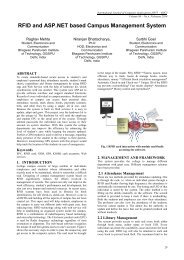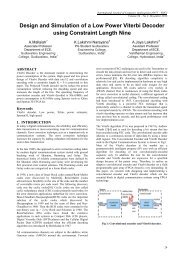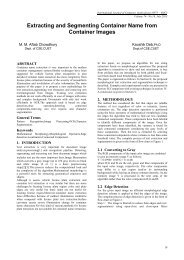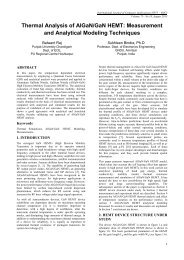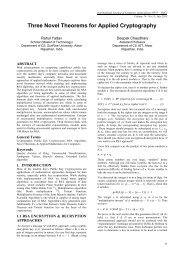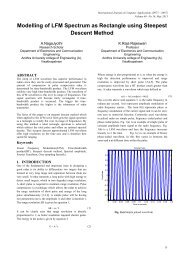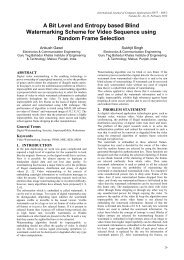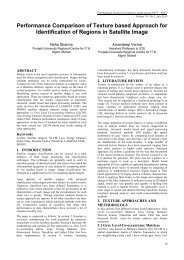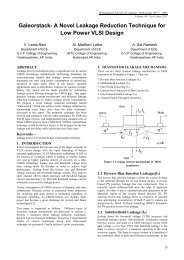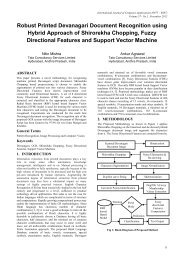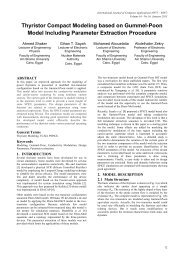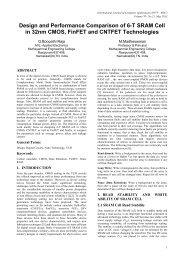Implementation of GB Interface using Internet Protocol
Implementation of GB Interface using Internet Protocol
Implementation of GB Interface using Internet Protocol
Create successful ePaper yourself
Turn your PDF publications into a flip-book with our unique Google optimized e-Paper software.
with external packet-switched networks, and is connected with<br />
SGSNs via an IP-based GPRS backbone network. The MS and<br />
the BSS communicates through the Um interface. The BSS and<br />
the SGSN are connected by the Gb interface with Frame Relay.<br />
Within the same GPRS network, SGSNs/GGSNs are connected<br />
through the Gn <strong>Interface</strong>. When SGSN and GGSN are in<br />
different GPRS networks, they are interconnected via the Gp<br />
interface. The GGSN connects to the external networks through<br />
the Gi interface. The MSC/VLR communicates with the BSS<br />
<strong>using</strong> the existing GSM A interface, and with the SGSN <strong>using</strong><br />
the Gs interface. The HLR connects to SGSN with the Gr<br />
interface and to GGSN with Gc interfaces. Both Gr and Gc<br />
follow GSM Mobile Application Part (MAP) protocol defined in<br />
GSM 09.02 [4]. The HLR and the VLR are connected through<br />
the existing GSM D interface. <strong>Interface</strong>s A, Gs, Gr, GC, and D<br />
are used for signalling without involving user data transmission<br />
in GPRS. Note that the A interface is used for both signalling<br />
and voice transmission in GSM. <strong>Interface</strong>s Um, Gb, Gn, Gp and<br />
Gi are used for both signalling and transmission in GPRS.<br />
2.1 GPRS in BSS<br />
GPRS uses the radio interface efficiently in two ways. Firstly, it<br />
enables a fast method for reserving radio channels. Secondly,<br />
the benefit <strong>of</strong> GPRS is the sharing <strong>of</strong> resources with circuit<br />
switched connections. GPRS packets can be transmitted in the<br />
free periods between circuit switched calls. Furthermore, GPRS<br />
provides immediate connectivity and high throughput. The main<br />
functions <strong>of</strong> the BSC with GPRS are to:<br />
� manage GPRS-specific radio network configuration<br />
� control access to GPRS radio resources<br />
� share radio resources between GPRS and circuit<br />
switched use<br />
� handle signalling between the MS, BTS and Serving<br />
GPRS Support Node<br />
2.2 Pooling Concept<br />
[Reference no: 1/287 01-F<strong>GB</strong> 101 256 Uen Rev A 2006-08-<br />
23]<br />
Traditionally in GPRS-based packet data networks, each<br />
SGSN is wholly responsible for its own service area. If the<br />
SGSN becomes unavailable for any reason, subscribers in the<br />
service area no longer have access to packet data services.<br />
SGSN Pool – which is standardized for GSM and WCDMA<br />
networks in 3GPP R5 –addresses this issue by introducing a<br />
more flexible and resource-efficient architecture with built-in<br />
network redundancy. With SGSN Pool, all the SGSNs in the<br />
network work together and the capacity load between them is<br />
distributed by the BSCs and RNCs. All BSCs and RNCs serving<br />
GSM and WCDMA radio access networks are connected to all<br />
SGSNs in the pool, as shown in Fig-2 below. If any SGSN<br />
become unavailable, any attached mobile devices will be<br />
automatically rerouted to another SGSN in the pool.<br />
2nd National Conference on Information and Communication Technology (NCICT) 2011<br />
Proceedings published in International Journal <strong>of</strong> Computer Applications® (IJCA)<br />
Fig 2: SGSN Pool overview<br />
3. <strong>GB</strong> OVER IP<br />
3.1 Technical Field <strong>of</strong> the Invention<br />
This invention relates to telecommunication systems and, more<br />
particularly, to a system and method in a General Packet Radio<br />
Service (GPRS) network for <strong>using</strong> a Gb interface, which has<br />
been modified to operate <strong>using</strong> the <strong>Internet</strong> <strong>Protocol</strong> (IP), to<br />
automatically configure Network Service Entity Identifiers<br />
(NSEIs) in a Base Station System (BSS) and a Serving GPRS<br />
Support Node (SGSN)<br />
3.2 Description <strong>of</strong> related art<br />
� The Gb interface is an interface in the GPRS<br />
network between the SGSN and the BSS based<br />
on the connection-oriented Frame Relay protocol.<br />
The protocol stack currently comprises an L1<br />
physical layer (related to Frame Relay), a<br />
Network Service (NS) layer, and a Base Station<br />
System GPRS <strong>Protocol</strong> (BSSGP) layer. The NS<br />
layer is divided into two sub-layers. The upper<br />
NS sub-layer is called the Network Service<br />
Control (NSC), and is like the glue with the<br />
BSSGP layer above. The lower NS sub-layer is<br />
called SubNetwork Service (SNS), and is like the<br />
glue with the underlying Frame Relay structure.<br />
� solution is to encapsulate the Frame Relay<br />
information in IP packets sent between the two<br />
nodes. Also, there are existing networks <strong>using</strong> the<br />
Gb interface over Frame Relay, and any new<br />
interface needs to be backward compatible to<br />
support these Frame Relay networks. Therefore,<br />
the new interface must have a protocol stack that<br />
supports both Frame Relay and IP.<br />
� It would be advantageous to have an interface<br />
between the BSS and the SGSN that is based on<br />
the IP protocol. There is a larger pool <strong>of</strong> products<br />
available for IP than for Frame Relay, and the use<br />
<strong>of</strong> IP allows the use <strong>of</strong> several different layer 1<br />
and layer 2 technologies (e.g., Frame Relay,<br />
Ethernet, fiber optics, etc.). In essence, the Gb<br />
interface would become carrier-independent and<br />
much more flexible in terms <strong>of</strong> routing. It would<br />
also be easier to maintain.<br />
� Basing the interface on IP would provide<br />
additional flexibility and features that exist in IP<br />
but not in Frame Relay. For example, an<br />
5



